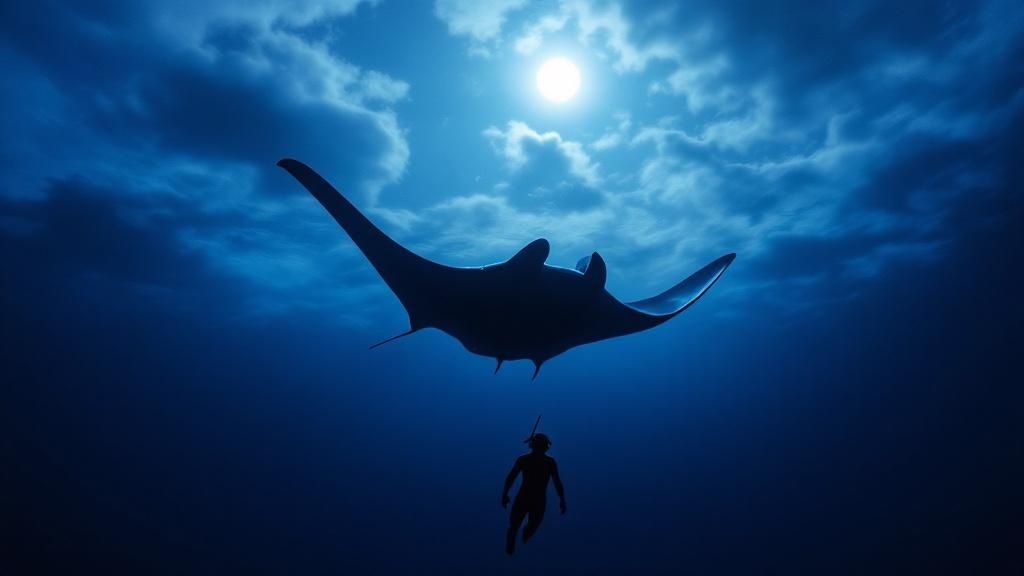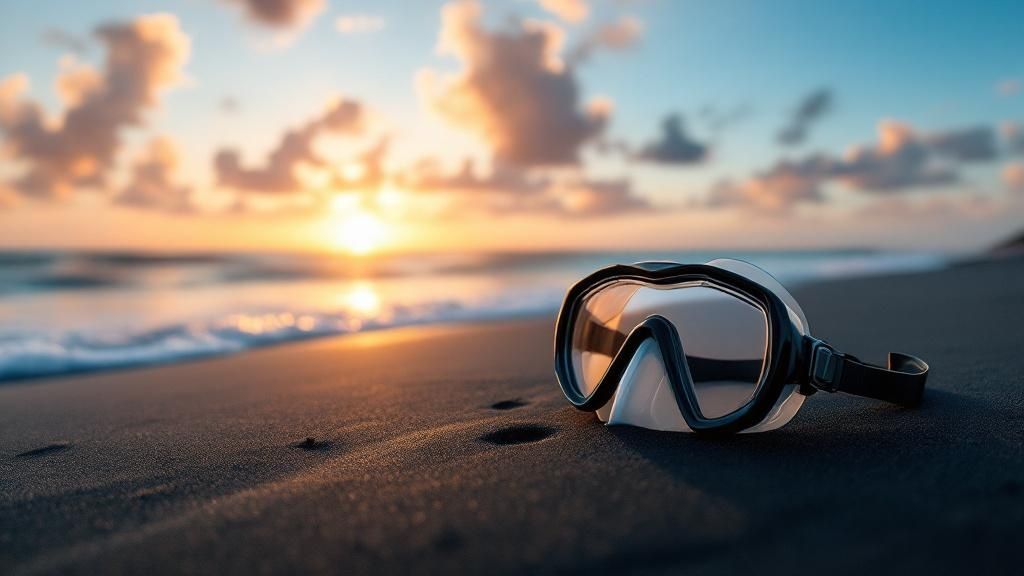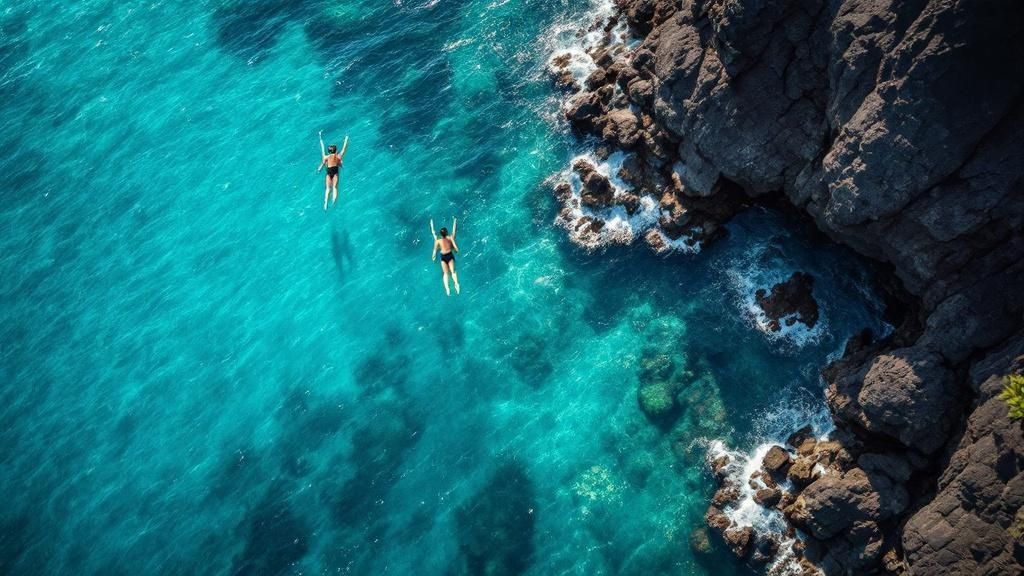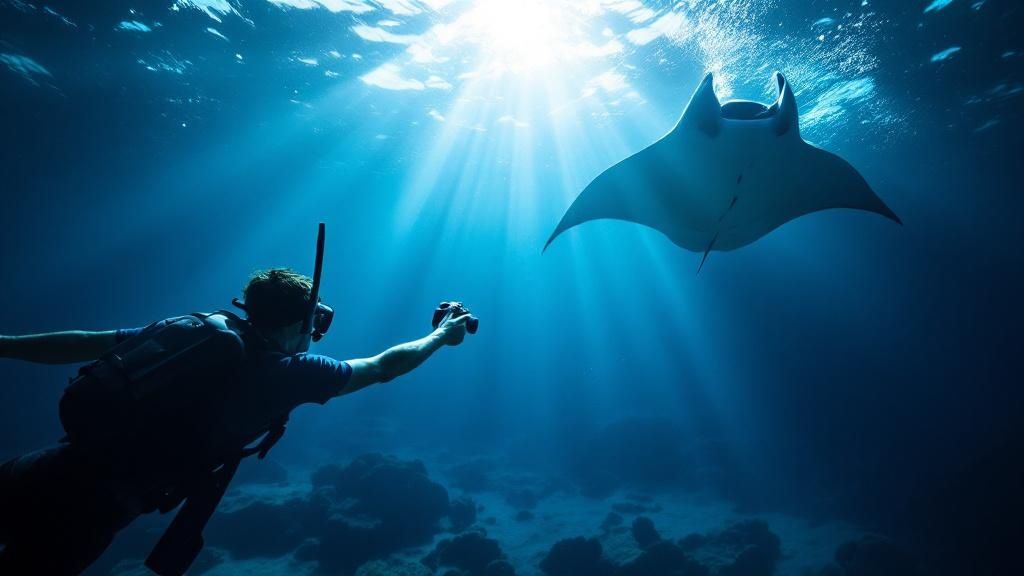Manta Ray Snorkel Big Island Guide
- Byron
- Aug 1
- 15 min read
If there's one adventure that defines the Big Island, it's the manta ray night snorkel. The Kona Coast is, without a doubt, the best place on the entire planet for this experience, offering a practically guaranteed and truly magical encounter with these gentle giants. Imagine floating in the calm, dark Pacific as majestic manta rays glide, loop, and barrel roll just inches beneath you. It’s absolutely surreal. For the best experience, we recommend booking a tour with Manta Ray Night Snorkel Hawaii.
Your Ultimate Guide to the Big Island Manta Ray Snorkel
Welcome! This is your complete guide to one of Hawaii’s most unforgettable underwater moments. This isn't just another snorkeling trip; it's a front-row seat to an incredible natural spectacle. The Kona coast has the perfect setup for this breathtaking adventure, making the manta ray night snorkel a memory you'll carry with you long after you've left Hawaii.
Before we dive in, see what fellow travelers are saying about this incredible tour with Manta Ray Night Snorkel Hawaii.

This guide will walk you through everything you need to know, so you can feel confident and excited about swimming with these gentle giants. For a fantastic tour operator that specializes in this unique encounter, you can explore the options on the Manta Ray Night Snorkel Hawaii homepage.
Why Is This Experience So Unique?
So, what makes the Kona experience different from seeing mantas anywhere else in the world? It all comes down to dinner time. At night, tour operators set up powerful, submerged lights that attract massive clouds of plankton—the manta rays’ favorite food. This creates a reliable and mesmerizing "underwater ballet" as the rays swoop in for their nightly feast, right in front of you.
The Big Island of Hawaii, particularly the Kona Coast, is world-famous for its manta ray snorkeling because of a thriving local population of over 450 identified individuals. This consistency leads to an impressive sighting success rate of 85-90% all year long.
Preparing for Your Adventure
Knowing what to expect is the key to soaking in every magical moment. In this guide, we'll walk you through every step of planning your manta ray snorkel on the Big Island. We’ll cover all the essential topics to ensure you have a safe, respectful, and genuinely awe-inspiring adventure.
Here’s a sneak peek at what we'll explore:
What to expect on the tour, from the boat ride to your time in the water.
How to choose the best tour operator for you.
Safety guidelines for both you and the manta rays (this is a big one!).
The science behind why Kona is such a global manta hotspot.
By the time you're done reading, you'll have all the info you need to book your tour and get ready for a once-in-a-lifetime experience. For even more expert tips, check out this detailed guide to manta ray snorkeling on the Big Island.
What to Expect on Your Night Snorkel Adventure
So, what’s it really like to go on one of these tours? Imagine this: you're floating in the warm, dark Pacific Ocean, the sun has just dipped below the horizon, and the stars are starting to pop out. Below you, absolute giants with wingspans wider than you are tall glide through the water like they're flying. That’s the feeling at the heart of the manta ray snorkel Big Island experience—it’s pure magic from start to finish. Knowing how the night unfolds will help you relax and just soak it all in.

Your adventure actually starts before you even step foot on a boat. Most tour operators have you check in at a harbor or marina along the beautiful Kona coast. This is where you'll meet the crew—usually a team of passionate, lifeguard-certified marine experts. They’ll get you all set up with the necessary gear, which typically includes a wetsuit top, snorkel, and mask.
Once everyone’s ready to go, you’ll hop aboard the boat for a quick ride out to one of the go-to manta viewing spots. Honestly, this ride is an experience in itself. Depending on when your tour is, you might catch a breathtaking Kona sunset lighting up the sky. Don't forget to watch the water, either! It’s pretty common to see spinner dolphins showing off and playing in the boat’s wake.
The Briefing and Getting into the Water
On the way out to the site, your guides will give you a full safety briefing. Pay close attention here, as this is really important stuff. They’ll cover everything from manta ray behavior and how to use your gear to the golden rule of "passive interaction"—which means look, but don't touch! They also share some incredible facts about these gentle giants, turning the boat ride into a fun learning session.
A key rule you'll hear is to stay flat on the surface of the water. Keeping horizontal makes the whole group predictable and safe for the mantas, giving them the confidence to swim right up close.
When you arrive, the crew sets up a floating light raft. This isn't just a handle to hold onto; it's the main attraction. The raft has powerful lights pointing down into the water. As soon as they flip the switch, these lights attract swarms of tiny plankton, which is what manta rays love to eat. It’s basically ringing the dinner bell for every manta in the area. You’ll then slip into the water, find a spot on the raft, and wait for the show to begin.
The Main Event: Manta Ray Encounters
What happens next is something you'll never forget. Drawn in by the massive plankton buffet, the manta rays rise up from the darkness. They swoop, soar, and do graceful barrel rolls just inches below you, with their huge mouths wide open to filter-feed. All you'll hear is the quiet lapping of the ocean and the occasional gasp of awe from your fellow snorkelers as these magnificent creatures perform their nightly ballet.
You'll spend about 40-45 minutes in the water, which is plenty of time to take in this incredible sight. It’s peaceful, powerful, and deeply moving. By holding onto the board, you become a silent observer in their world, witnessing one of nature’s most stunning displays up close. This is the moment that turns the manta ray snorkel Big Island tour into a memory you’ll cherish forever.
After your time in the water is up, the crew will help you back on board. They usually have snacks and hot drinks ready to warm you up for a relaxing boat ride back to the harbor under a sky full of stars.
How to Choose the Best Manta Ray Tour
Picking the right tour for your manta ray snorkel Big Island adventure is easily the most important decision you'll make. It’s not just about what you’ll see; the operator you go with shapes your entire experience and, more importantly, plays a role in protecting the mantas themselves. Let's walk through the options so you can find a tour that’s safe, responsible, and a perfect fit for you.

From big, stable catamarans to zippy little zodiacs, the choices can feel a bit overwhelming at first. But don't worry—each one offers a unique vibe, and understanding the differences is the key to an unforgettable night.
Large Boats vs. Small Boats
Right off the bat, you'll need to decide on the size of the boat. This choice really comes down to your personal comfort and what kind of atmosphere you're looking for.
Large Boat Tours: Think catamarans. These are your best bet if you get seasick, as their size makes for a much smoother, more stable ride. They also tend to have more amenities, like onboard restrooms and plenty of deck space. The trade-off? More passengers, which can sometimes lead to a crowded feel on the boat and in the water.
Small Boat Tours: Usually zodiac-style rafts, these trips offer a more intimate, adventurous experience with a much smaller group. You'll get more one-on-one time with your guides, who can share all sorts of cool facts. On the flip side, the ride is faster and bumpier, and you'll have fewer creature comforts. To get a better sense of the in-water part of the tour, check out our ultimate guide to your Manta Ray swim in Kona.
Deciding between a large, stable vessel and a smaller, more intimate one is a great first step. This table breaks down the main differences to help you see which one aligns better with your ideal night out on the water.
Comparing Manta Ray Snorkel Tour Features
Feature | Large Boat Tours | Small Boat Tours |
|---|---|---|
Vessel Type | Catamarans | Zodiacs/Rafts |
Group Size | Larger (20-50+ people) | Smaller (6-15 people) |
Ride Comfort | More stable, less bumpy | Faster, bumpier, more adventurous |
Amenities | Often have restrooms, more space | Fewer amenities, more basic |
Atmosphere | Social, bustling | Intimate, personalized |
Best For | Families, those prone to seasickness | Thrill-seekers, small groups |
Ultimately, both tour types will get you to the same amazing manta ray action. It’s all about choosing the journey that feels right for you.
Manta Village vs. Manta Heaven
The Big Island is famous for two primary spots where these gentle giants gather. While you can’t go wrong with either, they each have their own personality.
Manta Village (Keauhou Bay): This is the original, classic site, located just south of Kailua-Kona. The boat ride is super short since it's so close to shore. It's known for having incredibly reliable sightings, though its popularity means it can sometimes be the busier of the two locations.
Manta Heaven (Garden Eel Cove): You'll find this spot north of Kona, near the airport. The boat ride is a bit longer, but your reward can be a truly mind-blowing number of mantas—what we like to call a "manta storm."
Believe it or not, researchers have been studying the Kona mantas for years! Studies tracking individual mantas between 2009 and 2014 confirmed that they tend to stick to specific home areas. This research is a huge reason why tour operators can provide such a consistently magical experience.
What Really Matters When You Choose
Boat size and location are important, but a few other factors are critical. You'll want to find an operator that lives and breathes safety and sustainability.
Look for a "Manta Ray Green Listed" provider. This certification means the company has committed to strict, eco-friendly guidelines designed to protect the mantas and their habitat. It’s a simple way to know you're supporting responsible tourism.
Also, ask about the tour's total time, what gear they provide (a good wetsuit is a must!), and the guide-to-guest ratio. A smaller ratio is always better, as it means more attention and a safer swim. Choosing an operator who puts the mantas’ well-being first helps ensure this incredible natural wonder will be here for many years to come.
Snorkeling Safely and Respectfully with Manta Rays
When you're out on the water, the well-being of the magnificent manta rays and everyone on the tour is the absolute top priority. A truly successful manta ray snorkel Big Island adventure is one where both people and marine life have an amazing—and safe—experience. This all comes down to understanding and following a few simple but incredibly important guidelines.

The guiding principle here is "passive interaction." Think of yourself as a quiet, respectful guest in their home. You're there to observe their world without disturbing anything. The whole idea is to let the mantas go about their business naturally, which they'll happily do as long as they feel safe and unthreatened.
Once you’re in the water, you’ll be holding onto a specially designed flotation board. It’s absolutely essential to keep your hands on this board the entire time. This keeps you stable and, more importantly, prevents you from accidentally touching the mantas as they swim by.
The Golden Rules of Manta Interaction
To make sure every encounter is safe, all snorkelers need to follow a few core rules. These aren't just suggestions; they are strict standards enforced by every responsible tour operator to protect these gentle giants.
Observe Only, Never Touch: This is the big one. Manta rays have a delicate, protective layer of mucus on their skin that acts as a shield against bacteria. Touching them, even with the slightest brush of a finger, can wipe off this coating and leave them vulnerable to nasty infections.
Stay Horizontal: Always float flat on the water's surface while holding the light board. Trying to dive down or kicking your feet can easily startle the mantas or even strike them by mistake. This interrupts their feeding and causes them a lot of stress.
Don't Chase or Block Their Path: Let the mantas be in control. Never chase, grab at, or swim directly in front of one. If you block their path, they can feel trapped and will often just leave the area.
Lights Point Down: Your crew will have the main lights on the board perfectly positioned to attract plankton. If you're given a personal light, always keep it pointed straight down toward the seafloor, never into the eyes of the mantas.
Following these simple rules helps create a calm, predictable environment. That's what encourages the mantas to swim closer and stick around longer, giving you that breathtaking, up-close experience you came for.
Choosing an Eco-Conscious Operator
The single most important decision you can make for a respectful encounter is choosing a tour operator that puts manta ray conservation first. Look for companies that are "Manta Ray Green Listed" or follow similar strict, eco-friendly standards.
These guidelines were carefully developed over years by marine biologists and local experts to minimize our impact. When you choose a certified operator, you are directly supporting the long-term health of this incredible natural wonder for future generations.
These top-tier operators invest heavily in training their guides on manta ray behavior, biology, and safety protocols. They know how to manage their groups, maintain a safe distance, and educate everyone on board about why conservation is so critical. Their commitment is what keeps the manta ray snorkel Big Island experience a world-class model of responsible wildlife tourism. To learn more about the magic of being in the water with them, check out this guide to the manta ray night snorkeling experience.
Why Is Kona the World's Best Place to See Manta Rays?
What makes a manta ray snorkel on the Big Island so special? It’s not just a lucky accident. The Kona coast has become the world's most reliable place to see manta rays, thanks to a unique mix of geography, biology, and a little human discovery. When you understand the "why" behind it, the whole experience becomes even more amazing.
It all started decades ago when a hotel manager decided to aim floodlights into the ocean. He probably didn't expect what happened next. The bright lights drew in massive clouds of plankton, the microscopic organisms that manta rays love to eat. The local mantas quickly figured out that these lights were basically a nightly dinner bell, creating an all-you-can-eat buffet.
Today's tour operators use this exact same principle. They bring powerful, eco-friendly lights out on the water, creating a consistent feeding spot every evening. This is why sighting rates are so ridiculously high—often over 90%. You aren’t just hoping to stumble upon mantas; you're showing up for their scheduled dinner.
Getting to Know Kona's Gentle Giants
The mantas you'll see here are reef mantas (Mobula alfredi). Unlike some of their bigger, ocean-roaming cousins, reef mantas prefer to hang out in coastal areas, making them reliable residents of the Kona coast. They aren't just passing through; they live here.
These animals are also incredibly smart, boasting the largest brain-to-body size ratio of any fish. You can see their intelligence in how they interact with their environment—they're curious, not aggressive. And no, they don't have stingers like their stingray relatives, so they pose absolutely no threat to people.
What's really cool is that every manta ray has a unique pattern of spots on its belly, just like a human fingerprint. Marine biologists and local guides have used these patterns to identify and name hundreds of individual mantas over the years. You might hear your guide point out "Lefty" or "Big Bertha" and even share a story about them.
A lot of people mistakenly think manta rays are dangerous. The truth is, they're gentle filter-feeders that are completely harmless. If they get close, it's usually just out of pure curiosity, which makes the encounter that much more magical.
A One-of-a-Kind Population
While you can find manta rays in warm waters all over the world, the ones in Hawaii are particularly special. Genetic studies recently showed that the reef manta populations around the Hawaiian Islands are surprisingly isolated from each other. That means the mantas you see off the Big Island are part of a community that's genetically different from those near Maui or other islands. You can read the full research about these distinct manta populations to see just how unique they are.
This separation makes Kona’s manta community a fragile and precious group, numbering only a few hundred. Their isolation underscores why responsible tourism and conservation are so vital here. Every tour operator has a duty to protect this specific, irreplaceable population for years to come. If you're looking for more info on how to choose a responsible tour, check out our guide on the top manta ray snorkel tours in Kona.
Knowing all this changes your snorkel from just a fun activity to a real connection with a unique marine world. You're not just looking at fish—you're a guest in the dining room of an intelligent, distinct, and vulnerable community.
Your Questions Answered
Going on a manta ray snorkel on the Big Island is a huge thrill, but it’s totally normal to have some questions before you jump in. We get asked these all the time, so we’ve put together some straight-up answers to help you feel confident and ready. Once you know what to expect, you can just relax and enjoy the magic.
But don't just take our word for it—see what other snorkelers are saying. The reviews for Manta Ray Night Snorkel Hawaii really show what an incredible and well-run tour this is.
Let's get your questions sorted so you can look forward to a true once-in-a-lifetime experience.
Do I Need to Be a Strong Swimmer?
This is easily the most common question we hear, and the answer is a relief for many: no, you don't need to be an expert swimmer.
Here’s why: you won’t actually be swimming around. Instead, you'll be holding onto a big, custom-built float that looks like a raft. It has handles all around it and does all the work of keeping you buoyant. You just float on the surface, face down, and watch the show below.
This clever setup makes the tour accessible to almost anyone. As long as you’re comfortable putting your face in the water while wearing a snorkel mask, you’re good to go. The guides are also right there in the water with you, making sure everyone feels totally safe and secure the entire time.
What Should I Bring on the Tour?
The tour company provides the important stuff, but bringing a few personal items will make your trip a lot more comfortable. Think of it like packing a small beach bag for the evening.
Here’s a quick checklist of what I recommend grabbing:
A Towel: You’ll be happy to have it when you climb back onto the boat.
A Warm Jacket or Sweatshirt: Even in Hawaii, the boat ride back can feel chilly with the night breeze. Having something dry and warm to throw on is a game-changer.
Swimsuit: The easiest thing is to wear it under your clothes so you're ready to go.
Reusable Water Bottle: It's always a good idea to stay hydrated, and most eco-friendly tours appreciate you bringing your own bottle.
Motion Sickness Medicine: If you're prone to getting seasick, take something like Dramamine before you get on the boat. The ride is usually smooth, but it’s always better to be safe than sorry.
Waterproof Camera: You will want photos of this. A GoPro or a similar underwater camera is absolutely perfect for capturing the action.
Your wetsuit, mask, snorkel, and the light board are all provided, so you don't have to stress about bringing your own gear unless you have a favorite mask you can't live without.
Can Kids Go on the Tour?
Yes, absolutely! This is an amazing adventure for families. That said, most companies have age and height requirements to make sure the safety gear fits correctly. Typically, kids need to be at least 5-6 years old and tall enough for the smallest wetsuits.
Because you’re just floating and holding onto a raft, it's a calm activity that's perfect for children who are comfortable in the ocean. It’s an unforgettable experience that will spark their curiosity like nothing else. Just be sure to double-check the specific age policies with your tour operator when you book.
What Happens if the Weather Is Bad?
Your safety is always the top priority. The tour captains are experts at reading the local weather and ocean conditions. If the wind is too strong, the swells are too big, or it's pouring rain, the trip will be canceled.
When that happens, you'll have two simple options:
Reschedule: You can hop on another tour on a different night at no extra cost.
Get a Full Refund: If you can't find another time that works, you'll get all your money back.
This is exactly why it’s a smart move to book your manta snorkel for one of your first nights on the Big Island. It gives you plenty of wiggle room to reschedule if the weather doesn't cooperate.
Is There a Best Time of Year to See Manta Rays?
Here's one of the best parts about the manta ray snorkel on the Big Island: it's fantastic all year round! The reef manta rays here aren't migratory; they live along the Kona coast full-time. They reliably show up for their plankton buffet every single night.
That means there's no "off-season." The success rate for seeing mantas stays incredibly high—often over 90%—no matter which month you visit. While some people feel the activity is even better around a full moon, trust me when I say any night is a good night to see these gentle giants.
What if We Don’t See Any Manta Rays?
While sightings are almost a sure thing, we are dealing with wild animals in their natural home, so nothing can ever be 100% guaranteed. On very rare nights, the mantas just decide not to show up to the dinner party.
This is where reputable companies really shine. They almost all have a "manta guarantee." If you're on one of those rare tours where no mantas appear, most operators will let you come back another night for free (usually on a standby basis). Make sure to ask about this policy when you book. It's another great reason to schedule your tour early in your trip!
This kind of guarantee shows a real commitment to making sure you have an amazing experience. Booking with a trusted company like Manta Ray Night Snorkel Hawaii gives you that extra peace of mind. You can see all their great tour options on their homepage.
Comments